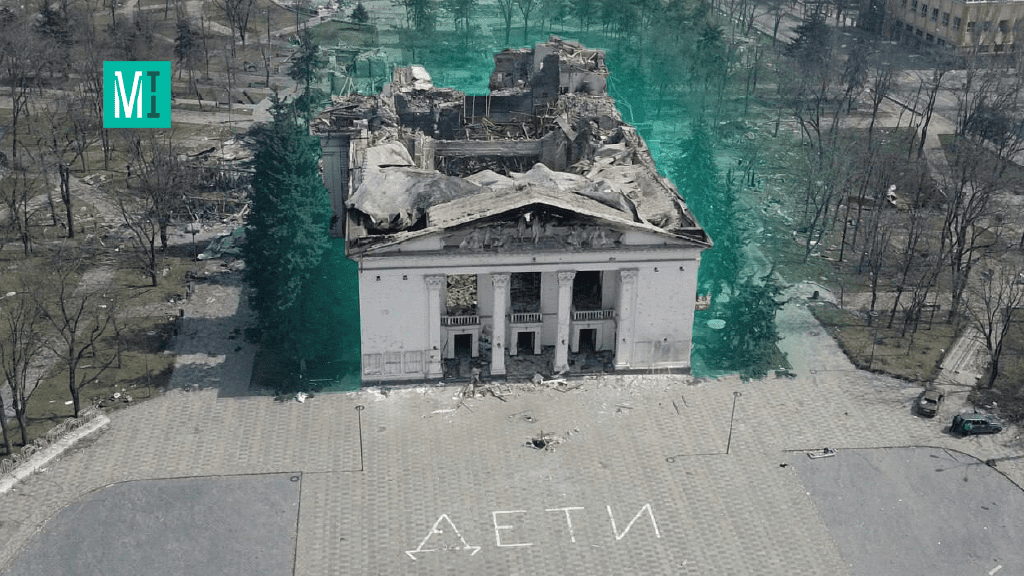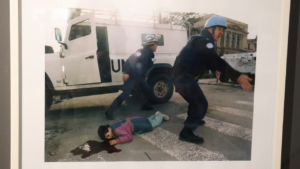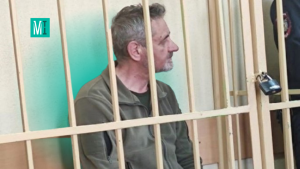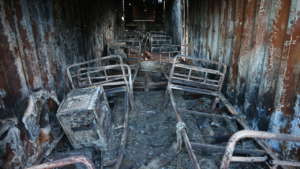Attack on Mariupol Drama Theater: How It Was. The Survivors’ Stories

A year ago, on March 16, 2022, the military of the Russian Federation destroyed Mariupol Drama Theater with an extra-high-power airstrike. According to Mariupol City Council, the attack resulted in the death of about 300 people. Associated Press states the figure of 600 in its investigation. However, the exact number of the victims is still unknown as the Ukrainian investigators have no access to the scene of the war crime. The Russian Federation claims that Azov National Guard Regiment had blown up the building of the theater from the inside. Yet, this version is being refuted by the witnesses. The MIHR team talked to some of them.
“I worked at a convenience store, so I met the morning of February 24 at my workplace. I was told the war had started, but I did not believe it. An endless stream of people rushed to the store. I sat down at the cash desk at 4 A.M. The shelves in the store were almost empty by 10 A.M. For some reason, they were buying not cans and biscuits, which are more durable, but what is tastier: frozen meat, pelmeni. The shopping pattern became more appropriate later,” recalls Iryna Kuzmenko from Mariupol.
“Half a million people lived in the city. At first, nobody was afraid. Everybody thought that it would be like it had been in 2014. Everybody went to work. There were no people who would not go to work due to the hostilities,” says Sergiy, whose name is changed for safety reasons.
Then the Russian military started shelling Mariupol, but there was no extraordinary panic among the residents.
“The parking lots around all multi-storey buildings were occupied. Nobody was leaving. I did not see people packing,” shares Kateryna, who also asks to change her name for safety reasons. She says that people were just actively withdrawing cash from ATMs, which caused fast depletion of money. The residents were also massively buying up food. Due to the high demand, the personnel of a popular supermarket did not have time to display food on the shelves.
“They would just put out a box of product, and the buyers would take everything from it. I was buying cereals. I thought that they would last longer if that went on. Everybody wanted to wait out,” adds Kateryna.
The situation was getting tense. The shelling intensified, and the Russian military used aviation. They were shelling the residential buildings and civil infrastructure of Mariupol. The city lost electricity, district water supply, gas, heating, and communications. Mariupol ended up in a blockade.
Kateryna failed to leave with her family during the first days of the full-scale invasion. While they had communications, the family watched the situation on social networks. From the information they received, they understood that leaving was dangerous.
“We lived in a multi-storey building in the eastern part of the city. When we were running out to see what was hit, we had the impression from what we saw that the goal of the Russians was to liberate the city not from mythical fascists but from people,” shares Kateryna, “They aimed at service lines, hit a hospital, a supermarket. When no foodstuffs were left, a bakery was still in operation near Azovstal, but they hit it too.” Like many other people of Mariupol, Kateryna’s family was hiding from the shelling in a basement of a multi-storey building, which was not fit for such purpose. But they had nothing left to do: they lived there, taking meals and meeting their physiological needs.
On March 5, Mariupol City Council informed about a ceasefire from 9 A.M. to 4 P.M. and about the evacuation of the residents. The people were to gather at three places to be taken by municipal buses. The Drama Theater was one of such places. Built in 1959 in the historical center of the city, it was the city’s calling card and one of the favorite holiday spots for the locals and city visitors. It housed 742 seats. On February 22, just before the full-scale invasion of the Russian Federation, a pro-Ukrainian meeting of about a thousand locals was held there, in the Teatralna Square, in front of the Drama Theater. The same evening, the Boombox Group gave a concert on the stage of the Drama Theater. They were the last to perform there.

Pro-Ukrainian meeting in Mariupol on Feb. 22, 2022. Source: facebook/Evgeny Sosnovsky
They were waiting for the evacuation
Hence, on March 5, 2022, people started flocking to the theater in anticipation of evacuation. “That day, we felt a lull, and we thought we had already been seized. All people came out. Police officers and men from territorial defense came up to us and said that the evacuation would take place in half an hour from three points: the Drama Theater, Illichivets Sports Facility, and the Philharmonic. It took us five minutes to grab our belongings, food, and one thin blanket and to head for the Drama Theater. There were lots of cars flowing to the theater from all directions. All the people had white bands on and were ready to be evacuated. Suddenly everybody stopped, and a policeman said there would be no green corridor and, before the shelling started, people should go back. We decided to wait out in the Drama Theater,” tells Kateryna.
There were no living conditions in the theater, but people believed that they would stay there for a little while. Besides, it included an air-raid shelter, although there was no space for everybody.
“Those who lived nearby brought sofas to the air-raid shelter and arranged sleeping spaces. But not everybody was allowed to use them. The others had to look for free space in other rooms and halls. The people were sitting in the lobby, on the windowsills, or between the windows. Many people had cats or dogs with them. One man always had his parrot with him. The parrot was tame. It was jumping and running on its owner. We entered the auditorium and settled to sleep on the floor,” says Kateryna.
The personnel of the Drama Theater forbade people to settle in the audience seats because an immense chandelier hung above them, which could fall down and crash the people during shelling. To be able to sit down, the people would wrench the seats and carry them out of the auditorium.

Auditorium of the Drama Theater. Source: Telegram / Mariupol City Council
According to the witnesses interviewed by MIHR, first there was chaos in the theater. Then its personnel started arranging a life together. They selected those responsible for the order in the theater from the active young people who tied white bands on their sleeves to be recognized. Part of the people pitched in and started cooking and distributing meals.
“There were a lot of people. They all had to be fed and watered. Furthermore, it was cold. The representatives of the territorial defense allowed to open stores with food and clothes. Coats, baby clothes, and underwear were brought for the people from those stores. It was freezing, the temperature would drop down to minus 10 degrees Celsius (14°F). It was like sleeping outside in the city park. The space was large. But no heating, no blankets. I would wake up at night from shivering all over with cold. Moreover, we heard incessant explosions – either on the left or on the right. We listened attentively to know better what to do and where to run. It was not possible to sleep well. Four or five hours of sleep at best. Sometimes we would run to take cover in the bomb shelter. Sometimes we would venture out,” says Kateryna.
In order to feed the people, the men made a makeshift grill outside the theater. They took big saucepans and other utensils from the cafes and restaurants next to the theater. Some of the young people and women volunteered to cook soups. They arranged a feeding center with two counters in the theater’s cloakroom. One counter serviced children and moms with children; the other was for the others. Soup was served once a day.
Later the territorial defense and the police brought a field kitchen to the Drama Theater. Then the meal situation got better. “Our family had a little saucepan, so we would drink boiled water and eat biscuits and sweet food to have at least some glucose in our systems,” adds Kateryna. Besides, volunteer women were selected to keep the water closets in order.
A thousand inside and a curfew
According to the witnesses, at first, just those expecting evacuation came to the theater: about 500 persons. But day by day, there were more and more people. Those whose houses were destroyed by the Russians started coming. On one occasion, the number of people there reached a thousand. For lack of space, they occupied the first and second floors of the theater. Food problems began.
“I spent two hours in the line for food then but didn’t get it. They ran out of food,” Kateryna recalls.
For security reasons, those who lived in the theater introduced a curfew: they closed its doors at 6 P.M. “We had a rule: as soon as it got dark at 6 P.M., we closed the doors. We did not let anybody in, nor anybody out. That was what the police advised us to do; otherwise it would have been dangerous,” says Sergiy.
According to the witnesses, they also arranged a volunteer center in the Drama Theater. The territorial defenders brought plastic barrels of water and a generator there. The locals who were concerned about those in the theater also helped, bringing toiletries, matches, etc. There people received food, water and information on what was going on, as there was no communication by mobile phones. They learned the news from new people arriving at the theater.
“I clearly remember a man, who looked shabby, coming to the theater and telling that a house at 96 Metalurgiv Ave. had been hit by a bomb and collapsed. About 200 people had stayed in the basements there. A basement became a common grave for them. Even those who might have survived could not get out of there,” recalls Sergiy.
“One day, somebody made cards: on small pieces of paper, it was stated that Mariupol and Volnovakha were hero cities now. At that time, it did not matter for us, of course, how our cities were called. The main thing was for their residents to survive,” shares Kateryna.
The Drama Theater became a saving place not only for those who lived there, but also for the residents of the neighboring houses. At least they could find water there.
Olena Abramova lived 200 meters from the theater. When the Russian military started shelling the city, she moved to a house next door, at 32 Arkhitektora Nilsena (former Engelsa) Street. Residents of different homes found shelter in the basement of that building, which housed a children’s dancing club. Olena says that at least a hundred persons stayed there. According to her, the Russian military were shelling the city from various weapons, including aviation.
“We would go to take water from the theater, on the side of which a fire hydrant was installed. While I was waiting in the line, I learned from a lady that during the construction of the Drama Theater, the local underground spring was used to install reservoirs for firemen,” explains Olena.
Children sign, aircraft, and two heavy-duty aerial bombs
The Russian troops moved forward and intensified their shelling of the city center: from various weapons at different times of day and night. To save the lives of the locals, first of all, children volunteers wrote two huge words, Children, with white paint on two sides of the Drama Theater to be clearly seen from the sky. With that, they wanted to show the Russian pilots that the theater was a civil building. At that time, according to the witnesses, children from the local orphanage also found shelter there.

Children inscriptions in Russian in front of the Drama Theater. The picture was taken on March 14, 2022. Source: Maxar Technologies
On March 13, 2022, people learned that it was possible to leave Mariupol safely. People were leaving in columns of vehicles. “I went out to Myru Ave. on March 13 or 14. Plenty of cars were by the side of the road near the Drama Theater. The downtown was crowded, and people were getting ready to leave the city. Then they drove towards the port. The next day, when I went out to the avenue again, it was empty. A lot of people left then, including those from our basement,” recalls Olena Abramova.
She tells that when there were planes in the sky, people would take shelter in basements. A plane usually dropped two bombs at a time. People would go out of basements only after they heard that the second bomb had been dropped and everything had got quiet.
“Once, an airstrike was at night. My neighbor from the second floor was spending the night in his apartment. The impact was so strong that the neighbor, who slept in his bed, woke up in the opposite room with a window frame in his hands. The next day, on March 16, a shockwave blew out the entrance doors of the apartments on each floor of the house except for the ground floor. That was that very airstrike on the Drama Theater,” recalls Olena.
According to her, it was about 10 A.M. when she heard the buzzing plane. Everybody ran for the basement right away. Then there was one sudden explosion, then another one, and the woman felt the shockwave.
“The basement walls that had housed a dance hall were faced with plastic. After the airstrike, there was a feeling as if somebody had rocked the plastic. ” All hell was breaking loose, and it seemed that now everything would fall on us from above,” says Olena.
During the airstrike, Kateryna and Sergiy were inside the theater, at the places of the boxes. They say that after part of the people had left, about 400 persons remained in the theater.
“All of a sudden, I saw a flash to the right, like a bright white neon light. And everything started in slow motion, as usually shown in films. It could have been a second, but it all was slower for me. The roof and the ceiling collapsed. The shockwave went in my direction. The storm of debris, pieces of stone, and plaster were sweeping in the whirl. The shockwave in the enclosed space pinned us to our armchairs. I tried to move, but I ended up back in the armchair. Impossible to breathe with one’s nose or mouth. The wave bends the body. I felt suffocated from clumps of dust. Probably due to the confined space, the wave was tossed from one wall to another, and only a terrifying choppy sound, “wo-wo,” was heard. Then they pulled me out of there,” recalls Kateryna. She was wounded in the head. “My family and I had not washed since February 28. My hair was filthy, and after the strike, it was also in dust, trash, and blood, like a big lump of dirt,” says the woman about her state.
Sergiy was contused, but he had time to react, covered his body, and curled up: “Out of the corner of my eye, I saw that the roof was thin at the place hit by the bomb. It broke through the roof and exploded in the wings. We were saved by the iron curtain which comes down on a scene in a theater.”

Satellite image of the Drama Theater as of March 29, 2022. Source: Maxar Technologies
After the explosion, a fire broke out: the wooden floor and scenery caught fire. Having recovered, the people would run out. It became clear that the Russians had hit the place which housed the field kitchen and the administrative section of the building.
“The same section included a basement, where the locals, theater personnel, and volunteers stayed. Allegedly, there were also orphan children, pregnant women, those who felt bad, and people with special needs. They all died,” recalls Kateryna.
There were a lot of wounded. Bodies lay outside near the destroyed field kitchen. Part of the strike survivors went to the Philharmonics, another place of refuge for the locals. At about noon the same day, Teatralna Square started to be shelled from mortars.
Half of those who had stayed were killed
“When things calmed down, I ventured out to see what had happened to my house. I saw gaping holes in places of the apartments. I saw the Drama Theater from the front side, a heap of stones and broken glass, but the front wall was still on, so I did not know the scale of destruction. I saw bodies in the streets. A man lay near a car with an empty plastic water canister in his hands. He lay like that for three days, not taken by anybody,” says Olena Abramova.
Soon after that, when the Russian troops occupied the center of Mariupol, Olena could come closer to the theater.
“A checkpoint was arranged near it, where they checked people’s passports. I looked in the direction of the theater, and it struck me what I saw: a heap of stones in its place. I felt I had to capture it and take pictures to share later. I took pictures with my phone secretly because I realized that I could be watched,” recalls Olena. She notes that when she was leaving the occupied territory, the invaders inspected her at a checkpoint and deleted those pictures.

Drama Theater after the Airstrike. Screenshot from the BBC video, April 11, 2022
According to those who suffered and witnessed the attack on Mariupol Drama Theater, half of the people who stayed in the theater at that time died due to the airstrike.
“There were about 15 persons in the kitchen; all were killed. In the basement, which housed backstage technical premises, there were about 70–100 persons. There was also a backstage administrative building: food was stored in one room, and toiletries and medications in another one. There was also a room where a doctor who resided nearby would come to provide medical support for those who lived in the Drama Theater. That space could have included about a hundred persons. People also stayed on the first and second floors and did not stand a chance of surviving; thus, they all died,” explains Sergiy.
He also recalls a small girl who remained an orphan. Before the airstrike, her parents went to the kitchen and got killed there. The people who knew the family took the girl.
Right after the tragedy, those who had stayed in the theater and waited for the Russians started claiming the military of the Azov Regiment had carried out the shelling.
“But that is not true,” says Katerina, noting that there were no military at all in the theater. “Moreover, when we were still going from the left bank to the theater on March 5, we did not see any Ukrainian military machinery on our way. And no combat operations were conducted from the territory of the Drama Theater. There was a feeling that the Russian troops just wanted to wipe us out and did not care where their shells were falling.”

Demolition of the Drama Theater. Source: Telegram / Mariupol City Council
On June 12, 2022, the Russian information resources stated that the Drama Theater would resume its operation on September 10, 2022. Ilya Solonin, the pseudo-director of the theater appointed by the invaders, promised that the new theater season would open with “two or three dance, variety and concert pieces and with a theatrical performance.” Instead, the occupation powers started demolishing the theater remnants in December of 2022, eliminating the traces of the war crime perpetrated by Russia’s armed forces.









